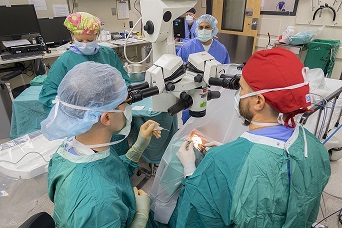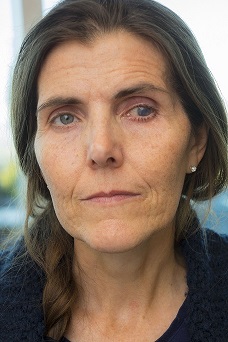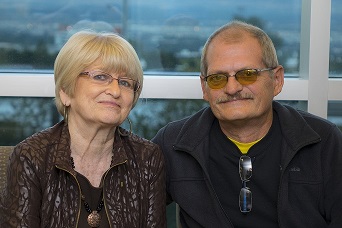Charity Surgery Day

Before sunrise on Saturday, October 10, 2015, groups of patients, eye surgeons and chief residents, and more than 40 volunteers at three Utah sites were on hand to participate in the first statewide Charity Surgery Day. By the end of the day, 34 Utahns in need had their lives changed with sight-restoring surgeries. As one grateful patient said after his cataract was removed, "It's a whole new world!"
Progressive Program Expands
Participating organizations included the University of Utah's John A. Moran Eye Center, The Eye Institute of Utah, and the St. George Eye Center a first in terms of a cooperative effort. In 2012, residents, and medical students at the Moran Eye Center pioneered a charitable model in which the operating room is run on a Saturday as it would be during the week. The difference is that physicians, nurses, and other staff members volunteer their time and patients are not billed for their care. It has proven a cost-efficient way to provide care to low-income, uninsured or under-insured people with treatable eye conditions many of whom cannot work because of their vision loss.
Complex, Compelling Cases
Often, the cases presented on Charity Surgery Day are complex, and in most cases, patients have nowhere else to turn. Some of the population may be transient, or lack access to transportation, so it can be a challenge to get them to return to their physicians for post-operative exams. Moran solved that challenge this year by doing same-day post-ops on cataract patients.

Patient Melanie Brown, the 53-year-old recipient of a new cornea will continue to be carefully monitored, but her surgery, including a cataract lens replacement, by Dr. Mark Mifflin and chief resident Dr. Russell Swan, went smoothly much to her relief and that of her daughter, Samantha, who accompanied her to Moran. Melanie, who currently works two, sometimes three part-time jobs and struggles with public transportation, has been suffering from a viral disease that has affected her right eye for the past 20 years. For a while, she was able to control it with medication and drops. But as time went on, she experienced infections and had some scaring in her eye. It got so bad that she had a cornea transplant five years ago. At that time, doctors discovered a cataract, removed it, and replaced it with a lens. There were complications after that, including a scratch and an infection, and her eye started rejecting the first transplant. "I can't see out of that eye at all," she said before her surgery. "It's like looking through a frosted window. I can't drive, and I've been afraid of so many things riding a bike, even going down a slide with my grandson. I'm not as outgoing as I used to be. I just feel withdrawn. When I found out I was going to get this transplant, I was so excited it's hard to believe. It's a gift I can't repay, but now maybe I can come back around to myself again. My dream is to use my degree in photography and to document what it's like to see out of just one eye to tell my story and maybe other people's stories, too."
Tim Haight, age 54, arrived at Moran with his mother, Connie. Walking with a cane and wearing tinted glasses, he was both excited and weary. "He's had a long hard, road," said

Connie. "But on the calendar for today's date, he wrote, ‘first ray of good luck.' "
While working as a mechanic at Boeing in Seattle, Tim "exploded a disk" in his back, ended up losing his job, his home, and his car, and had to move back to Draper, settling in his mom's basement. "I have a commercial driver's license, which is kind of my only hope for work now, but when I went to renew it, I failed. I found out I had a cataract. It's like looking through wax paper. You compensate, but it's hard. I read with a magnifying glass. My other eye isn't so great either and my mom has been paying for my medications, so today is amazing. To be honest with you, I didn't think I had a chance. On top of everything else, it's been lonely." Tim's hobbies include making big salt water aquariums. He likes to cook and has been doing his mom's gardening. "I was so happy to see that note on his calendar," says Connie. "This is going make a huge difference."
Bringing Attention to Preventable Blindness
"Good vision plays a basic role in health and quality of life. There are a lot of individuals who lack eye care because they fall outside of the system for a variety of reasons. We want to help everyone who needs it, not just those who can afford it," says Randall J Olson, MD, Chair and CEO of the Moran Eye Center. "We were excited when the ASCRS Foundation approached us about a partnership because it brings so much more attention, financial assistance, and volunteer resources to the problem of preventable blindness in the US. We've seen our program grow from one Saturday a year to two, and we are extremely gratified that others are joining in."
Charity Surgeries Completed October 10:
- Moran Eye Center 15 cataracts, 1 cornea transplant
- Eye Institute of Utah 14 cataract, 1 trabulectomy
- St. George Eye Center 3 cataracts
In 2014, Moran was selected as one of five founding members of the American Society of Cataract and Refractive Surgery (ASCRS) Foundation's Operation Sight network, whose mission is to provide a centralized approach for organizations and volunteer surgeons wishing to end cataract* blindness in the US. Saturday's program was funded in part by ASCRS and supported by organizations who donated supplies, medication, equipment, and cataract lenses. The Utah Lions Eye Bank donated tissue for a cornea transplant at Moran.
The following organizations donated supplies medication, equipment, and cataract lenses:
Abbot Medical Optics ─ intraocular lenses, post-op drops, misc. supplies for surgery; ALCON – intraocular lenses, misc. supplies for surgery; Synergy Health – Surgical packs used in OR and for sterilizing; MST – OR/surgical supplies; FCI Ophthalmics ─ OR/surgical supplies; Dutch Ophthalmic USA ─ OR/surgical supplies.
*A cataract is a clouding of the lens of the eye an area that is normally transparent. The clouding prevents light rays from passing through the lens and focusing on the retina. Over time, the cataract may grow larger, making it difficult to see. This condition plays a major role in unemployment and even homelessness, as visual impairment makes it difficult to find or keep a job. Cataract surgery, in which the lens is removed and replaced with a clear, artificial lens, is one of the safest and most common surgeries around the world, enabling people to greatly improve their health and quality of life.